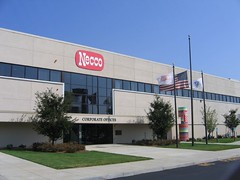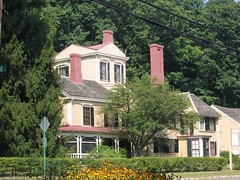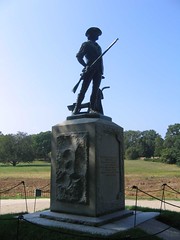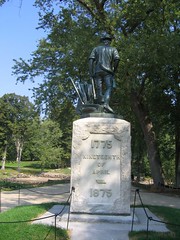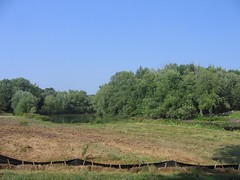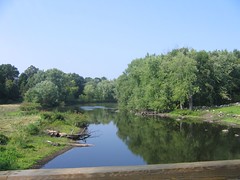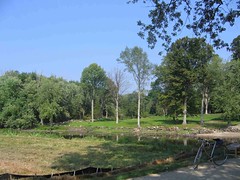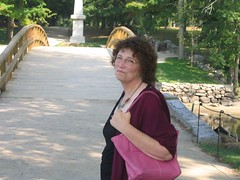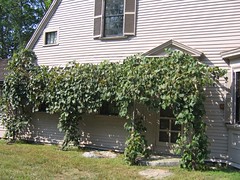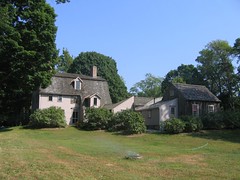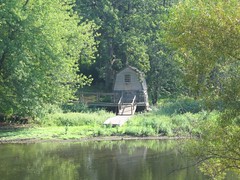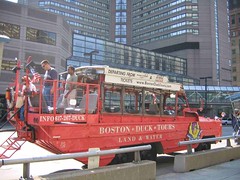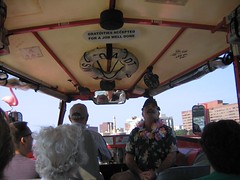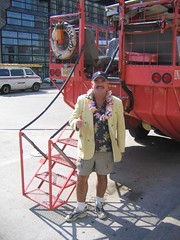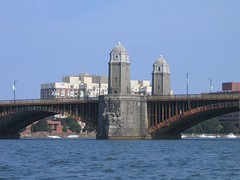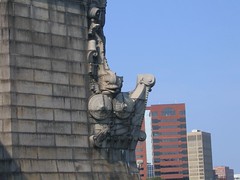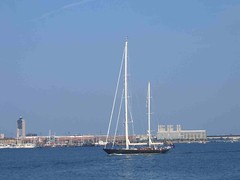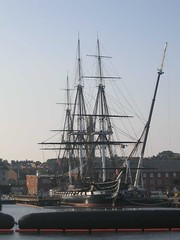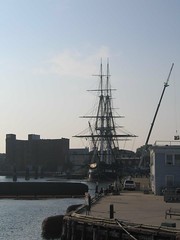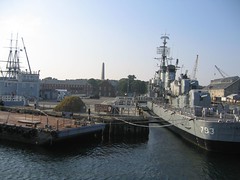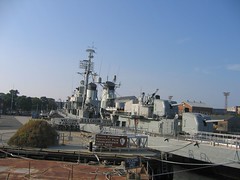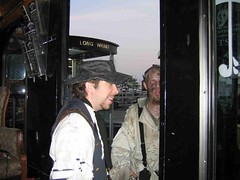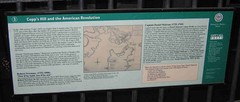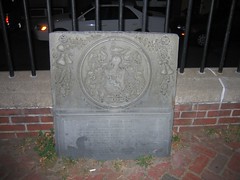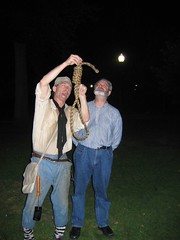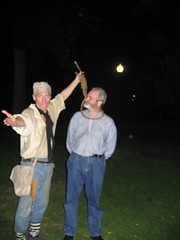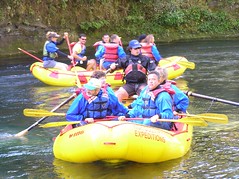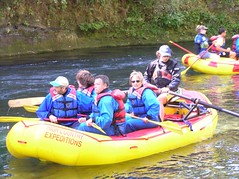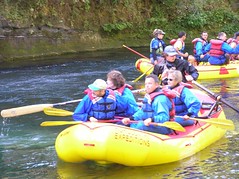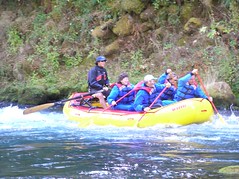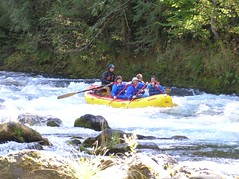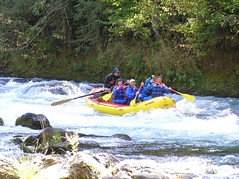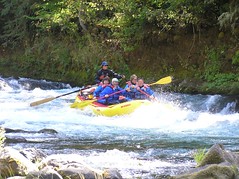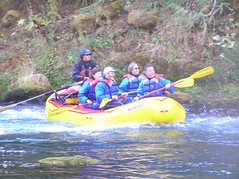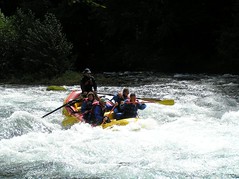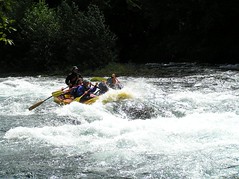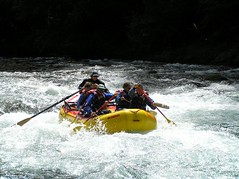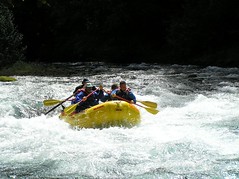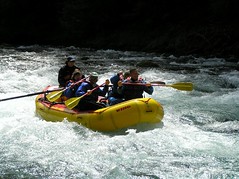Boston was grand fun and we're going to do it again. (Note: We had plenty of lobster while we were there. I'm sure that'll elicit cries of deep and abiding sympathy from all of you dear readers.) It was time to pack up and head west to visit dear friends, Andras and Deirdre. But first, we needed to get our car.
For those of you unfamiliar with Boston, let me explain something: you don't have to be crazy to drive in Boston, but it sure helps. Boston is post-graduate driving. I wasn't interested in trying to drive around Boston at all so we had made arrangements to pick up our Enterprise rental car at the airport (the offer of "free prick-up and delivery" notwithstanding).
We got to the Enterprise rental car location and they offered us an upgrade to the car we normally drive for an additional $5/day, which we jumped on. It wasn't the same color, but wotthehell; we knew what it felt like and how it handled. I got directions to a Bank of America. We headed to the bank. I had a lot to do ultimately, so it took a little while. I asked the teller, who was a very helpful person, where I might find a Starbuck's in the area. She wasn't sure, so she asked her boss who was in the next cage. He said, "Well, you know, this is actually an historic district of Massachusetts. It's probably the only place where there isn't a Starbuck's nearby." I laughed. He suggested we could head into Boston--only about 5 miles away as the crow flies but could've been an hour as the crow drives--where there were Starbuck's facing other Starbuck's across the street from each other (we'd seen 'em).
We got lost heading out from the bank. (It turned out later that there was a really confusing and unmarked roundabout we needed to have navigated differently.) I ended up going down one road and looking for somewhere to cut back up to the road and try again. No luck, so I turned the other way into a large parking lot to get back to the road and keep going until I found some way to get headed in the direction I was trying to go.
And then I stopped. And I got out of the car. And I took a picture. Yes, we'd stumbled onto the corporate headquarters of the NECCO Company! You can see the Necco Wafers on the side of the door. How very cool!! It had never dawned on me after years of enjoying NECCO Wafers that "NECCO" is an acronym for "New England Confectionary Company." According to the history on their web page, they recently acquired Clark Bar, so if you're a fan of Clark Bars, that's who makes 'em now.
Well, we finally escaped the Greater Boston area and headed north to Salem. The Babe had a desire to see the Salem Witch Museum and I had to admit a certain morbid curiousity myself. Salem's a very pretty little town and the museum isn't nearly as bad for misinformation as I thought it was going to be--in fact, the part on the witch trials themselves was pretty good--but the stuff on contemporary Wicca and paganism was pretty pathetic and the gift shop was truly ghastly for appealing to stereotypes. Oh, well, it could've been a heckuva lot worse than it was.
We were heading west to Worthington, but we made a couple stops on the way. Our next stop was up to the Lexington and Concord area. Some of this was for the Revolutionary War stuff, but the Babe had one very particular objective in mind: the Wayside. The Wayside was the home of Louisa May Alcott, Margaret Sidney and Nathaniel Hawthorne. Sadly, the house was closed the day we were there so we couldn't see the inside, but the outside was gorgeous. Hawthorne expanded the house considerably when he was there.
The Wayside is part of the Minuteman National Historical Park and very near to the house is the site of the first engagement of the British troops and the Minutemen. We drove up the road a little farther and then walked across a bridge to look at the Minuteman statue.
This was the battle that Paul Revere, William Dawes, and a few others rode to tell people about. The British were coming to Concord to destroy rebel caches of supplies. (They found some, but most of the caches were moved to other towns.) And it was here that the British first fired on the Minutemen and vice versa. The Brits prevailed against the first group, who were badly outnumbered, but were ultimately routed
I took photos of the fields around this. It's beautiful there and I had a hard time envisioning the battle. On the other hand, I was able to see how easy it'd be for the British troops to be harried along the road by snipers: it's very woody along the road from Boston to Concord and it'd be a piece of cake to hide in the woods and take potshots at the troops coming by, particularly when you know they're coming by and they're obligingly wearing red to make them easier to see.
I was able to sneak a good shot of the Babe while we were there (hence the look on her face). It's very difficult getting her to pose for pictures, so I takes 'em where I c'n gets 'em.
We walked back up the path to the main road. One of the things we'd walked past as we went down was Ralph Waldo Emerson's house.
The house is beautiful. It has a large, rolling lawn and several outbuildings. There's a vegetable garden that's probably about half an acre off to one side in the front. And the river is down the hill from the house to make lovely sounds in the evenings.
Before we left the area, we stopped at a delightful cheese shop in town and got provisions. Then, having driven by yet another Unitarian Church, we headed west towards Worthington for dinner and friends.
